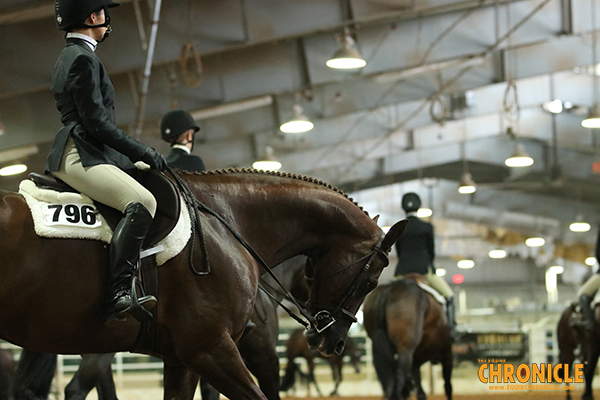COVID-19 Schooling Survival Guide- Equitation

By: Brittany Bevis
We’re back with another edition of our highly popular series- COVID-19 Schooling Survival Guide– and this time we’re focusing on Equitation On The Flat with Shannon McCulloch Bacon. With a little assistance from AQHA amateur competitor, Maria Salazar, we have a video companion to the article, at the bottom of the page, that illustrates the pattern. In addition, the ladies have added some bonus footage showing three, potential, problem areas and the solution for each.
Let’s get started!
Starting with the sitting trot, Shannon notes that it’s ideal to get up to your desired pace within a couple of strides. The downward transition to a walk should happen smoothly and without a halt. Think of it as having no deceleration in pace, but instead a solid transition into a flat-footed walk.
The first turn is a 360 degree pivot on the forehand to the left, followed immediately by a 90 degree pivot on the forehand to the right. Both turns should have solid and complete closures. The rider should take care not to over or under pivot. Shannon notes that a correct closure on the 90 degree turn is essential in order to line up the horse correctly for a straight back, which is the next maneuver.
“With the forehand pivot needing a contained forward motion, followed by a back, make sure your horse is balanced on the forehand closure before asking for the back,” Shannon says. “Otherwise, the horse could end up having to balance themselves and back crooked or require a large correction from the rider’s leg.”
Ideally, Shannon would like to see the trot on the left diagonal being picked up in the first sequence of steps. “If the rider misses the diagonal and has to sit another sequence, it won’t have the impact that picking up the diagonal on the first sequence will,” Shannon explains. “Sitting for any further can get a rider into the penalty zone.”
 The transition into a right lead canter should take place in the middle of the arena. Therefore, it’s important to know your horse’s skill set and plan accordingly. If it takes your horse a little longer to get collected for the transition to the canter, then you need to start asking for the transition a little before the middle of the arena.
The transition into a right lead canter should take place in the middle of the arena. Therefore, it’s important to know your horse’s skill set and plan accordingly. If it takes your horse a little longer to get collected for the transition to the canter, then you need to start asking for the transition a little before the middle of the arena.
Shannon would like to see a rider be up to speed into the hand gallop within three strides. Be sure to show a difference in speed for the collected canter that takes place around the end of the arena. The hand gallop in two point that takes place across the diagonal should be at least the pace of the hand gallop in seat, and perhaps a bit more, since it’s set on a diagonal line, and the hand gallop in seat was set on a circle.
The transition to a posting trot should take place past the center of the area, so the rider should cross the center before asking for the trot. “Since the posting trot is coming from the hand gallop in two point, the diagonal should be picked up without sitting,” Shannon says. “The pattern calls for the right diagonal, which is the opposite diagonal that comes naturally when coming from the right lead. I put that in to raise the degree of difficulty in the pattern.”
The trot on the right diagonal then goes into a two point trot around the corner of the arena. There should be no change in pace from the posting trot. The two point into the left lead canter is right after a corner and should be smooth. “The rider should come to seat and perform the canter transition simultaneously,” Shannon says.
There is another difficult transition coming up next. Picking up the left diagonal from the left lead is the opposite of what comes naturally and increases the level of difficulty. The final transition to a walk from the trot should be just like the first at the onset of the pattern. The walk should be flat-footed with no deceleration trot steps prior to the walk transition.
EC TV- COVID-19 Schooling Survival Guide- Equitation
We’re back with another edition of our highly popular series- COVID-19 Schooling Survival Guide– and this time we’re focusing on Equitation On The Flat with Shannon McCulloch Bacon. With a little assistance from AQHA amateur competitor, Maria Squires Salazar, we have a video companion to the article that illustrates one doozy of a pattern. In addition, the ladies have added some bonus footage showing three, potential, problem areas and the solution for each.Click here to read the article for tips and tricks from Shannon!http://www.equinechronicle.com/covid-19-schooling-survival-guide-equitation/#TheEquineChronicle#QuarantineTrainingStay tuned for the next in our series- Showmanship with Shannon Vroegh. Let us know what discipline you'd like to see featured next!
Posted by The Equine Chronicle on Wednesday, April 22, 2020
Stay tuned to EquineChronicle.com for the next in our COVID-19 Schooling Survival Guide- Showmanship with Shannon Vroegh! Email B.Bevis@EquineChronicle.com to tell us which discipline you’d like to be featured next.










